A Simple Solution for Fetching Data From a Headless CMS in a Dialogflow Chatbot
I often get the question, why does Dialogflow not have a CMS? So non-techy people can modify webhook fulfillment answers, without having to train models or use the Dialogflow console. The thing is, Dialogflow can be integrated with anything you like.
In this tutorial I will make use of a headless CMS; Sanity.
You can use any CMS, even Wordpress, but it makes things easier when there are (out of the box) REST APIs to use. This is what a headless CMS can do really well. It detaches the content from a webpage in order to reuse it in various contexts such as Mobile Apps or Chatbots.
In my Dialogflow, Django, Angular example I am using Django as a CMS to import user accounts. In fact, I am using the Django Rest module, to communicate with Django via a Rest API.
In this tutorial I will make use of a headless CMS; Sanity.
Dialogflow
To prepare Dialogflow with dynamic content, let’s create some entities and intents.
This example, creates a multilingual help desk chatbot. In the Dialogflow settings panel I have enabled the following two languages: English and French.
In the entities screen I have created 2 entities: systems and useractions.
Systems holds a bunch of computer system names, that all map to a key. For example InsidePayments belongs to key ibb in entity systems.

Dialogflow Entities
The entity useractions contains user actions such as delete, add, edit.
For every content item in my CMS, I will need to create an intent with training phrases. Here’s an example of intent name: 333. It has a bunch of training phrases, such as:
“How do I edit a new account in TopMortgage”.
This intent holds 2 required parameters, which needs to be filled, in order to filter the CMS content items. paramUserActions & paramSystems.
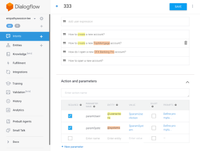
A Dialogflow Intent with required parameters
You will need to make sure that all your intents that need to fetch information from a CMS, have the webhook fulfillment enabled:
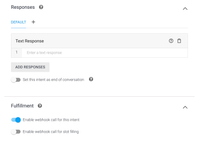
And that’s it for the Dialogflow part. Now let’s move on to Sanity.
Sanity
I’m installing Sanity on my localhost, since I will only use the Sanity Studio to write content items. In case you want to deliver this environment to your (non techy) customers, you could install Sanity on a Compute Engine Node.js VM.
- Install Sanity
sudo npm install -g @sanity/cli
sanity init
Login with a Google account, Github or your own email account. Click on the link which is shown on the command line, and accept the terms & conditions:
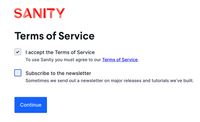
2. Back on the command line:
Provide a Project name: Chatbot CMS
Default Dataset configuration: Y
Output Path: /home/admin/chatbotcms
Schema: None
Add Samples: No
3. Let’s modify the Sanity schema:
cd /home/admin/chatbotcms/schemas |
Paste & Save the contents of:
Schema.js
nano simpleresponse.js |
Paste & Save the contents of:
simpleresponse.js
4. Start Sanity
cd chatbotcms |
5. Navigate to localhost:3333
Click on Intent > +
Add the content pages:
Here it’s important that you stick to the Dialogflow mappings.
- Note the Intent name (id) which is the same as the intent name 333 in Dialogflow!
- System name (paramSystem) maps to the Dialogflow entity key ibb in systems
- User Action (paramUserAction) maps to the Dialogflow entity key add in useractions
For the rest this item needs to have a readable title which will be visible in Sanity. And 2 chatbot responses. One in English and one in French:
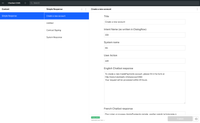
You can create multiple content items. For each user action and system combination its own item.
Now let’s query our data:
6. Click on Vision in the Sanity menu
Use the following GROQ query to get all simple response items:
\*\[\_type == ‘simpleresponse’\]
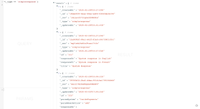
Use the following query to filter the items on the specific intent name (id) and parameters paramSystem & paramUserAction. As an output let’s just show the response in English language:
\*\[\_type == ‘simpleresponse’ && |
Params:
{ |
And notice the result:
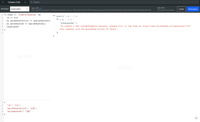
Alright so the content is present. We can filter for the contents through GROQ queries. The only thing that’s left to do is to implement webhook fulfillment code in Dialogflow, which can run this query, but uses the parameters provided by Dialogflow through slot filling.
Dialogflow
In the Dialogflow inline editor, we can use the following code:
Use the following package.json:
package.json
And the following index.js:
index.js
This code implements the Sanity NPM client. You will need to specify the Sanity project ID and dataset name. (In case you lost these, you can find it in the Sanity installation folder, sanity.json). This way it knows to query the content items that belong to your project.
The Sanity client method: client.fetch() takes the GROQ query with the parameters provided by the Dialogflow agent.
Within the Firebase Cloud function, it implements the Dialogflow agent, and retrieves the parameters and agent locale from the Dialogflow agent. The correct intent will be matched by these lines of code:
let intentMap = new Map(); |
The only important thing to remember, is that these lines will need to be inside the resolved promise of client.fetch otherwise you will likely get a timing issue and thus Dialogflow returns with a matched intent, without the CMS results.
Now you can test your expression in the Dialogflow console:
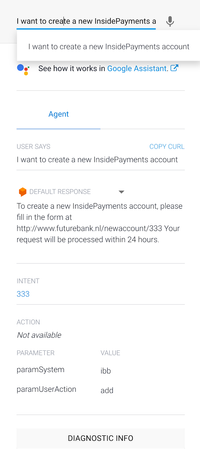
Based on the Agent locale, it will return the language item of choice, from the data which is inside of the headless Sanity CMS.
And there you go, here’s a simple solution for fetching data from a headless CMS (Sanity) in a Dialogflow Chatbot!